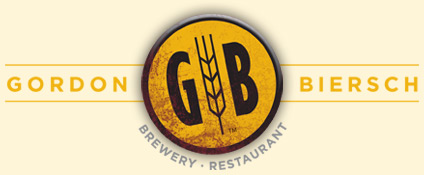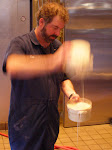
It is a classic cliché as the year comes to a close to reminisce and take stock. The highlight of my year in beer was this summer as I managed to find myself on three different continents over three successive weeks when my European vacation dovetailed with a business trip to the Gordon Biersch in Taiwan. It was a bit discombobulating. There was a wide diversity of environment and cultures I witnessed with the quick juxtaposition of the Old World that inspired me both personally and professionally, followed by a sojourn to the New World, at least as an emerging beer market, that got me thinking about what I call the “American Exceptionalism” in brewing.
According to the always accurate Wikipedia, “That is the philosophy that refers to the theory that the United States is qualitatively different from other states. In this view, America's Exceptionalism stems from its emergence from a revolution, becoming ‘the first new nation,’ and developing a uniquely American ideology; based on liberty, egalitarianism, individualism, populism and laissez-faire.”
Ironically, though the concept originated with Alexis de Tocqueville in the 1830s, and the term is most often used by neoconservatives in the political arena when implying that the USA is superior to every other country on Earth, it was actually coined by Joseph Stalin in the 1930s.
What I mean by applying the phrase American Exceptionalism to beer is that it is here in the good old US of A where you find the widest variety of consistently delicious and innovative beers in the world. American brewers have fermented a revolution by taking bits and pieces of all other nations different zymurgical traditions and mashed them together with our melting pot zeitgeist. On tap at any respectable beer bar in America you can find a cavalcade of craft beers; complex and extreme ales, drawing their pedigrees from England and Belgium but going far beyond their progenitors, exhibiting all manner of sweet malt character, enigmatic yeast esters and mouth puckering hop bitterness. They will be living in harmony beside some elegantly smooth clean lagers of German and Czech origin. With very few exceptions, this is not something you see in other countries whose faucets are dominated by the ersatz suds of massive multinational brands.
Of course, it was not always this way in the USA. Turn the clock back a few decades and America was the laughing stock of the brewing universe, as Prohibition and the privations of the Second World War left us with nothing save light lager styles. These were made with rice or corn by gigantic conglomerates that seemed to be in a race to increase their bottom lines by removing all characteristics of their beers that could be defined as flavor.
Those were dark times back when I started my personal journey with beer. I was just thirteen in 1979 and my mom would pick me up a colorful bottle of some exotic, esoteric and usually European beer each weekend. I would add it to my collection of colorful bottles that eventually took up a wall in my room. (Sad that if I were to do the same for my kids today I’d certainly be arrested and probably end up the subject of a Nancy Grace venom spewing rant.) They were moslty imports and they were the only alternative for a budding yet ignorant young beer geek. At the time I didn’t realize that the old oxidized imports weren’t meant to taste like the box the bottles came it. I thought they were delicious, even though drinking them offered the same sensation as sucking on the Sunday paper.
Fast forward ten years, while still in college studying history, I started brewing professionally at the first brew pub in Colorado, and we looked to the English and Germans as our guides. Since I never got to backpack across Europe I relied on others to reassure me that the Bitter, Stout, Pilsner and Hefeweizens we produced closely resembled the piquant perfection you would find in pubs and bier gardens back on “The Continent.”
It took another twenty years before I finally got to take a business trip to Deutschland and sit in a beautifully bucolic Bamberg bier garden and experience Gemütlichkeit, the feeling of profound joy that comes from imbibing impeccably poured clean crisp lager. It was compounded by the confirmation that, yes I was doing the right thing with my life by trying to bring this sense of comfort and cohesion to people back home.
Although Gemütlichkeit was great for both professional and personal reasons Germany was not the “trip of a lifetime." That would be how my sixteen year old son Liam aptly described the vacation we took to England and Ireland together last June. I grew up immersed in my Irish heritage. My father was the kind of American Irish Catholic who would vote for a Kennedy who wasn’t running, or even alive. It was sipping out of his beer mug as a boy that I found my professional calling, and he always promised to take me to the Emerald Isle of our origin.
Tragically “Poppy” passed before we had the opportunity to make the trip. So it was a big check off my bucket list when Liam whispered, “I can’t believe we’re finally here, the great green land of our forefathers...” into my ear as our Ryanair flight was touching down in Dublin. It sounds schmaltzy but since his autism usually keeps him quite quiet, this comment hit me like a musical mash up of “Danny Boy” and “Cats in the Cradle.”
We had flown over from London where we had a fantastically frenetic and fun filled week of castles, museums and monuments with a big group of extended family. “Hey look kids: Big Ben, Parliament.” There I was excited to drink true British cask conditioned Bitter, only to be let down time and again by pubs that hadn’t cleaned their beer lines since the Blitz. Thankfully, I had the advice of colleagues who unanimously recommended the Borough Market area, which did not disappoint. There was one tiny pub called “The Rake” that made the biggest impression, as it not only had the best of British beers but also a decent selection from across the Channel, and even a few crazy craft beers all the way from Colorado.
My favorite pub in Dublin actually had a similar wide selection in addition to making several well crafted ales and lagers of their own. It was quite a coincidence to find Brian Taft, one of our former Gordon Biersch brewers, back brewing for The Porter House where we met for a pint. A true imperial pint where the glass holds 20 plus ounces and there is a line guaranteeing the guest that that they are getting a full amount, a not so precious pet peeve of mine.
Since Brian brewed in both cultures he as a perspective that eludes most observers. He said it was tough going for small breweries in Europe because people were hyper loyal to their own brand, resisting change and not particularly open to extremes in taste, whether that be malt, hops, alcohol or yeast esters. He lamented the “dumbing down” influence of light American and European lagers preferred by younger Irish drinkers. He recommended several places to get the perfect pint of The Black Stuff however, based on freshness and who had mastered art or perfect pour.
The pinnacle of these places was the Gravity Bar atop the Guinness Store house at the St. James Gate brewery itself, with a spectacular 360 degree view of Dublin. It was there a Joyce like epiphany came to me. We taste not just with our eyes, noses, and tongues, but with a ton of archetypal cultural baggage that flows through our veins. That Guinness was the greatest because I was imbibing it in Ireland. The Black Stuff tastes better in a Dingle pub for the same reasons that Dinty Moore Stew is delicious when cooked over a camp fire, even though it is indistinguishable from dog food when prepared on a stove at home. And Corona is slightly less reminiscent of the liquid coming from a dogs lifted leg when you are on a white sandy beach with your beautiful wife by your side. Beer brands carry national, culture, and aspirational identities and Guinness is perhaps the best example of this, never mind that it is no longer an Irish Company and it is produced all over the planet. Corona is barely Mexican, and none of the big American breweries, who wrap themselves in the Stars and Stripes at stock car races, are American owned. All are merely smoke screen brands in the stable of multi-national consortiums.
Yet we cling to these faux experiences paradoxically because they make us feel more real. Donning lederhosen and drinking Oktoberfest Marzen style lager out of a giant liter Stein while noshing on a knockwurst is a way of celebrating your cultural heritage, or at least participating in a tradition that helps us feel comfortable and connected, if only for a few hours in the suburban sprawl comically called a “lifestyle center.”
Since our mind and memory is so strongly stimulated by our olfactory system it makes sense the particularly pungent aromas of beer play a big part in celebrating and defining who we are as humans. It is why Paulaner even has a pub in Taipei serving pretzels and beer they make themselves in Taiwan. The whole scene seems surreal, as did going to Gordon Biersch there. Yet I was blissfully blown away by just how good our beer was and a single sip caused my homesickness to subside.
I was more than a little concerned as I headed to Taipei, the brewer William Chang did not come to us with any experience or formal brewing education. On top of that he spoke almost no English and if you poured several gallons out of a keg of beer it would still weigh more than his slight self. I was sure if the confusing nomenclature of brewing did not trip him up, the shear physicality of the profession would kill him. If success of his mission wasn't impossible it was certainly improbable, and he was succeeding sensationally.
William was making some of the best beer in company thousands of miles away with little support. His brewery was immaculately clean and impeccably organized as was every one of the three GB restaurants he supplied. This made my job of auditing operations joyously simple, and provided the opportunity to check out the other small breweries and beer joints in Taipei.
The food in the densely populated metropolis of over six million was diverse and delicious, but I wish I could say the same for the malt based libations. Thankfully it had radically improved from the decade before when I had last visited to open a brewery with my previous employer. Still, selections were limited outside of the ubiquitous Taiwan Beer, produced by what was until recently called the Taiwan Beer and Wine Monopoly and is actually owned by the state. It will never sell outside of the country because it oxidizes instantly and tastes like one of Abe Vicoda’s suits.
There were the usual suspects of international light lagers and a handful of brewpubs in addition to the Paulaner location. Suffice to say there was no IPA to be found, but quizzically some prestigious Belgian Beers had made their way into the restaurants and markets. I gather the Asian palate is not keen on the blast of bitterness that American Craft Beer tends to bring.
I would wager that it is just a matter of time before the rest of the world catches onto Craft however; God knows we have to atone for the contribution of the Kardashians.







